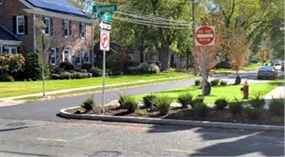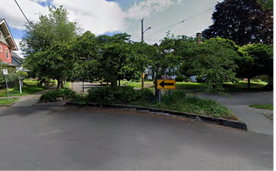Meet Scarsdale's New Village Planner Kellan Cantrell
- Details
- Written by Joanne Wallenstein
- Hits: 1058
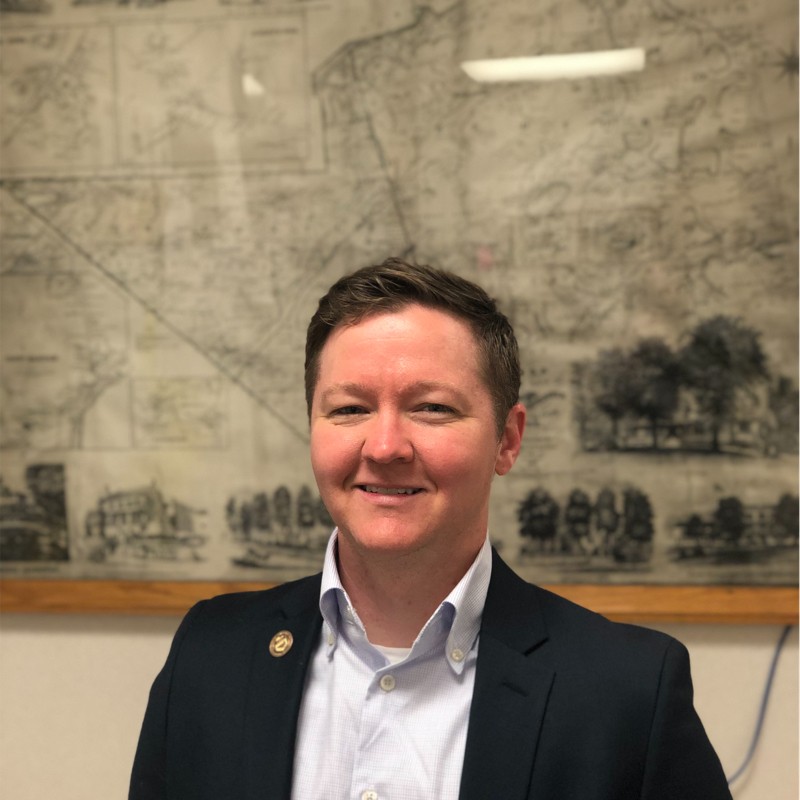 Scarsdale's new Village Planner Kellan Cantrell joined the team at Village Hall in June, 2023. With land use laws, flooding, tree removals, affordable housigng and zoning top of mind, we asked Cantrell for his views on some complex issues. Here is what we learned:
Scarsdale's new Village Planner Kellan Cantrell joined the team at Village Hall in June, 2023. With land use laws, flooding, tree removals, affordable housigng and zoning top of mind, we asked Cantrell for his views on some complex issues. Here is what we learned:
Tell us about yourself – where were you educated and where did you work before coming to Scarsdale?
I mostly grew up in South Carolina and still have deep roots there. After graduating from Indiana University with a Bachelors of the Arts in Anthropology I received my Masters of Science in City and Regional Planning from Pratt Institute in Brooklyn. I was in the Town of New Castle Planning Department for over 5 years prior to coming to Scarsdale. My wife grew up in Edgemont and has really helped me understand the area and its’ history.
Explain the role of the Village Planner.
The Village Planner provides technical support on land use issues, conducts and facilitates planning studies and is the Environmental Review Officer for the Village of Scarsdale. I have never been accused of being artistic but being a Planner is like being a painter, you bring together other professionals into a project in order to paint the overall picture of that project.
How have you found the new position so far? Does Scarsdale do anything differently than other places you have worked?
I have really enjoyed Scarsdale and the work I am undertaking here. The residents really care about the Village and the staff have been very welcoming, it has been an easy transition.
What are some of the challenges posed by our topography (flood plain)?
Climate change is something communities across the nation are struggling with on multiple levels. The increased frequency and severity of storms presents many challenges. Municipalities can use their regulatory powers and infrastructure investments to reduce exposure to the impacts of flooding. However, we are confronted with the dual realities that stormwater can’t be effectively controlled within our boundaries, as it is a regional problem calling for regional action, and that historic land use patterns in Westchester County have translated into properties being developed in locations prone to flooding. The Village leverages each of the tools available to us to minimize local exposure to flooding, including coordination between Planning, Engineering, and the Building Department, though our ability to cultivate significant improvement is limited by the regional circumstances we are confronted with. We will continue to work aggressively toward implementing strategies determined locally feasible and prudent while also seeking to grow interest in and commitment to regional mitigation and resilience strategies.
Scarsdale recently amended the building code in regard to construction within the property buffer. Can you explain the new code and comment on how it affects those who are renovating or building new homes?
This is a one of the continuing efforts by the Village to identify opportunities to enhance stormwater control and reduce stormwater runoff. The Village Code, Chapter 254, was amended recently to regulate any land disturbance within the 30-foot rear yard setback and the side yard setbacks that are already regulated via Chapter 310 of the Village Code (Zoning). Essentially this law ensures that any proposed disturbance within those prescribed areas is minimized or eliminated to reduce stormwater runoff and mitigate future flooding conditions posed by future development.
What’s your view on Governor Hochul’s bid to build affordable housing along the Metro North route?
It is difficult to legislate land use policy without an understanding of local context, as one size does not fit all and collaborative problem solving is superior to mandates. Following national trends, housing in our region is not affordable for many. Transit-oriented development has demonstrated value in reducing the combined costs of transportation and housing, substantial portions of most household budgets, thereby helping to make life, generally, more affordable for individuals and families. I am confident that our region will make progress in this area through thoughtful consideration of alternatives, appropriate public engagement, and collaboration between state, county, and local officials.
The housing stock in many areas across the United States is low due to many factors including population shifts, supply shortages during the pandemic and more recently high interest rates. Housing, especially housing affordability, is a complex and complicated topic. I don’t have a crystal ball, but I am optimistic that this situation will ease in the coming years as more housing is built across our region and workers have more flexibility to work remotely.
In the past few years we have had very low housing inventory for prospective buyers, driving up demand and prices. How do you view this situation?
See the above answer.
We also have developers purchasing older homes at average value and replacing them with homes valued at $4 million plus. In some cases the lots are subdivided and two very high end homes go up in place of one average home. Do you have any views on the mix of housing stock? Is it important to maintain a balance?
See the above answer.
Would it be legal to ban additional subdivisions due to the lack of infrastructure for stormwater and power lines to support additionally housing?
The Village Board continues to work with staff and counsel to identify any needed regulatory changes as such opportunities arise. Any proposed solutions will also seek out community input in order to gauge community support. Residents should keep in mind that any proposed subdivision in the Village must comply with the current laws of the Village Zoning Code.
Scarsdale has had limited success with historic preservation. In fact, the few homes that were voted worthy of preservation are now being disputed in court. What can the Village do to strengthen our preservation laws?
See the above answer.
How does our building code regarding housing bulk and lot coverage compare with neighboring towns or other places you have worked? Do you think any changes are needed?
Local land use laws vary widely from one municipality to the next, especially in a home rule sate. Each municipality has its own regulatory framework that is often difficult to compare. I know working collaboratively with the Scarsdale community, the Village Board and my colleagues on any future regulatory changes that are needed to our land use regulations can be developed with the common goal of keeping Scarsdale a welcoming and vibrant Village.
Former Mayor Jane Veron Appointed to SBA Committee
- Details
- Written by Joanne Wallenstein
- Hits: 1198
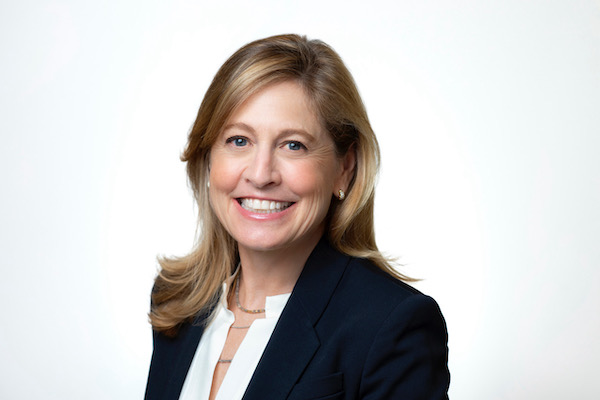 Former Mayor of Scarsdale Jane Veron joins a new federal committee aimed at fostering the success of small businesses across the United States. The new Investment Capital Advisory Committee (ICAC) is now part of the U.S. Small Business Administration (SBA), the leading advocate for America's 33 million small businesses. This committee will play a crucial role in enhancing access to investment capital for small businesses and startups across the nation.
Former Mayor of Scarsdale Jane Veron joins a new federal committee aimed at fostering the success of small businesses across the United States. The new Investment Capital Advisory Committee (ICAC) is now part of the U.S. Small Business Administration (SBA), the leading advocate for America's 33 million small businesses. This committee will play a crucial role in enhancing access to investment capital for small businesses and startups across the nation.
Isabella Casillas Guzman, head of the SBA, appointed Jane Veron to the 14-member ICAC. Veron is the CEO and co-founder of The Acceleration Project (TAP), a nonprofit organization dedicated to empowering under-resourced small business owners and accelerating their success. TAP is creating a more equitable and inclusive economy by providing advisory services to under-resourced small business owners across the country. Since co-founding TAP in 2012, Veron has grown the organization to nearly 200 consultants who serve thousands of small business owners annually. TAP's areas of expertise include finance, operations, strategy, marketing and support throughout the entire capital lifecycle.
In addition to her leadership of TAP, Veron’s commitment to public service led her to serve as Mayor of Scarsdale, New York from March 2021 to March 2023. She is the President of EJA Industries, a holding company for middle market private equity investments. Previously, Veron worked in strategy and marketing at Bain & Company and American Express.
In announcing the formation of the new committee, Isabella Casillas Guzman wrote: "The launch of SBA’s inaugural Investment Capital Advisory Committee with its distinguished membership will serve as a critical resource to the Biden-Harris Administration as we strengthen our policies and programs to foster a more inclusive investment ecosystem," said Administrator Guzman. "ICAC's insights and recommendations will help the SBA expand access to investment capital, increase public awareness of SBA resources, and identify and fill capital gaps facing small businesses and the fund managers seeking to support them."
“I’m honored to serve on the ICAC and am committed to furthering the committee's goals,” Jane Veron remarked. “At TAP, we believe in the power of collaboration and innovation to drive change. I look forward to working with my fellow committee members to advance the interests of small businesses and startups across the nation."
The ICAC, composed of diverse experts with extensive backgrounds in the U.S. private investment industry, is dedicated to advancing the mission of promoting, expanding, and fortifying the ecosystem of private funds that finance U.S. small businesses and startups. By doing so, it aims to facilitate funding opportunities for entrepreneurs and small business owners in traditionally underserved communities, thereby contributing to a more inclusive and equitable economic landscape.
No Easy Solutions to Speeding Problem on Sprague Road
- Details
- Written by Joanne Wallenstein
- Hits: 1276
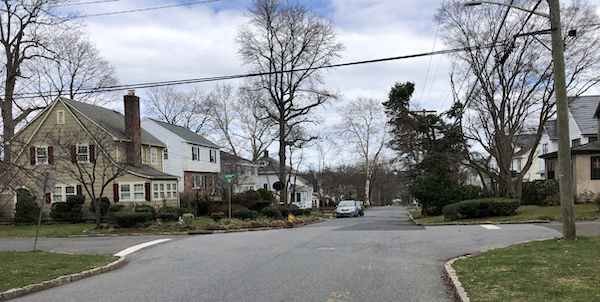 How can the Village slow down traffic on streets that are commonly used as shortcuts to avoid lights and stop signs on main routes?
How can the Village slow down traffic on streets that are commonly used as shortcuts to avoid lights and stop signs on main routes?
That was the subject of a meeting at Village Hall on Tuesday August 1 when Jeff Coleman, Superintendent of the Department of Public Works, presented recommendations from consultants FHI on how to slow down cars and trucks on Sprague Road. The consultants were retained in 2022 in response to resident complaints about speeding cars and near misses on their narrow residential street. They reported that due to the placement of stop signs on parallel streets (Boulevard and Locust) that also traverse the neighborhood, traffic has migrated to Sprague Road where there are no stop signs or lights.
The consultants studied the traffic flow and recommended the use of an array of traffic calming methods including chokers, traffic diversions, chicanes, half closures and traffic circles. See below for a diagram of these countermeasures.
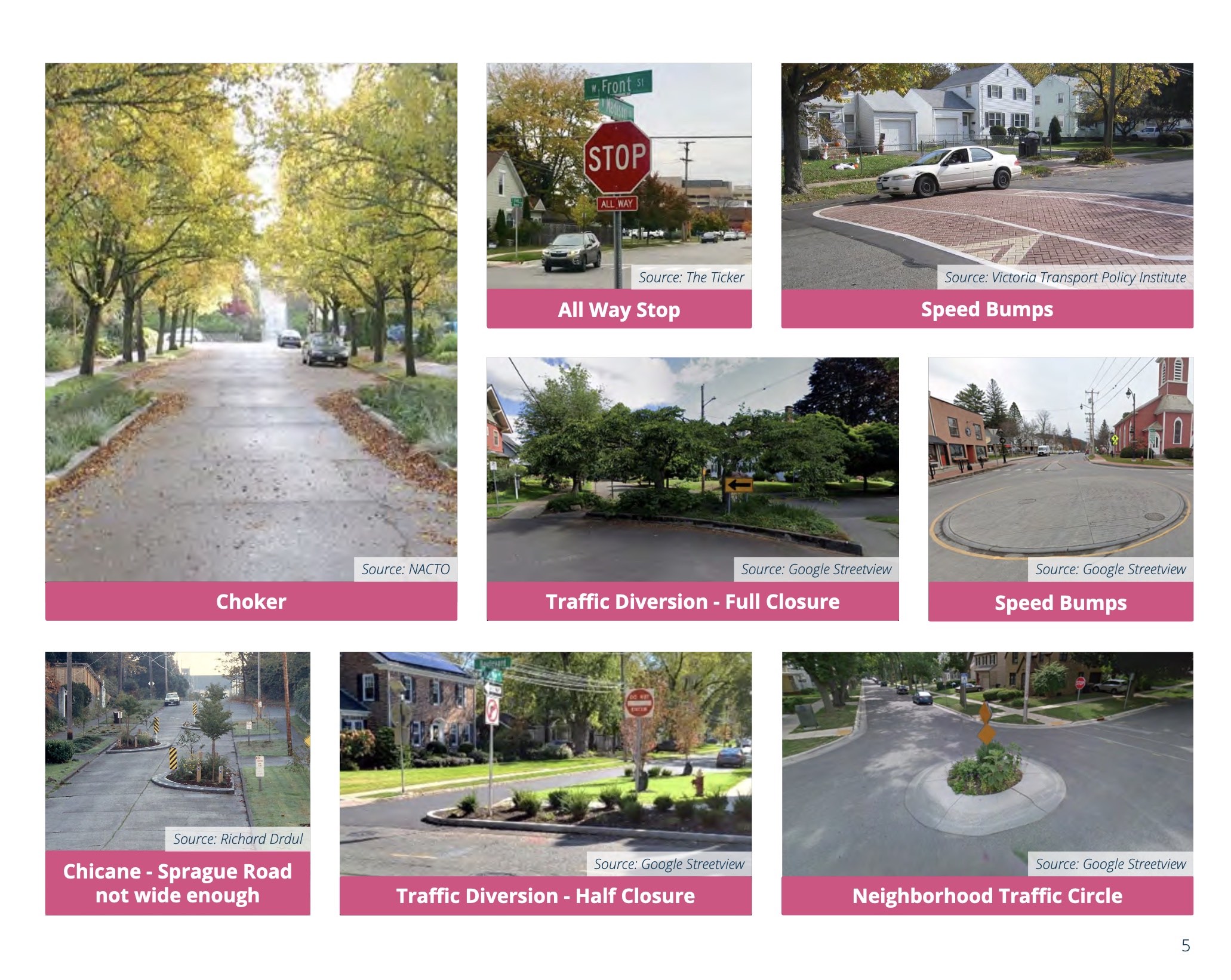
Though residents had asked for stop signs, Jeff Coleman who is a traffic engineer, explained that the situation on Sprague Road does not meet the required warrants listed in the federal and New York State Manual on Uniform Traffic Control Devices for the installation of stop signs and therefore, they cannot be installed. He explained, “Stop signs are warranted when there are five or more accidents in a one-year period in that location that could have been prevented by stop signs. He said the Village reviewed the accident reports for the previous years and did not find that this was the case.
Furthermore, the FHI report says, “Although some residents expressed support for stop signs, others noted that vehicles frequently roll through the stop signs. Additional conversations with the Village raised concerns about the usefulness of stop signs and the potential to increase crashes. Stop signs are typically not recommended as a traffic calming because studies have shown they have limited effectiveness in slowing vehicle speeds. Drivers frequently do not stop, particularly in locations where the stop is not perceived as needed. This can result in an increase in crashes. In rare circumstances such as locations with visibility constraints, stop signs have been implemented in locations that otherwise do not meet traffic volume requirements. This alternative was eliminated because the location does not appear to have the visibility concerns or overall traffic environment that would warrant an exception.”
From the consultant’s recommendations the Department of Public Works selected to two alternative schemes for consideration at the meeting:
Alternative 2
This alternative proposes the following changes:
1. Installation of neighborhood traffic circles at Gaylor Road, Nelson Road, Bradley Road, and White Road.
2. Installation of a choker east of Bell Road and east of Madison Road.
3. Curb radii reductions at Bell Road, Webster Road, Lyons Road, Madison Road, and Johnson Road.
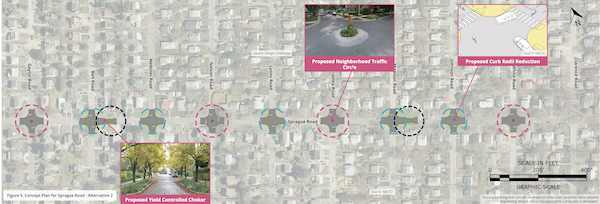
Alternative 3
This alternative proposes the following changes:
1. Installation of neighborhood traffic circles at Gaylor Road and White Road.
2. Installation of curb radii reductions at Bell Road, Webster Road, Lyons Road, Bradley Road, and Johnson
Road.
3. Installation of half closures at Nelson Road and Madison Road thereby prohibiting through travel along Sprague Road at both locations.
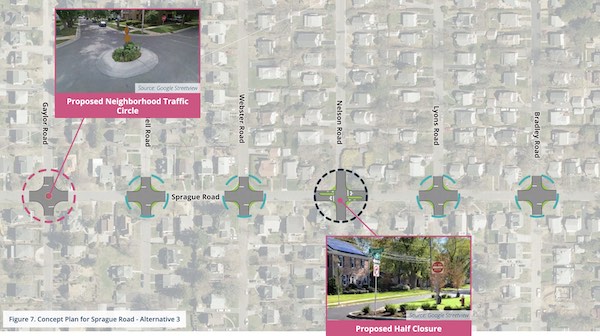
Asked for more background on the issue, Village Manager Rob Cole explained, “We have received a number of complaints over the years. There were analyses that showed there were more accidents there than in other parts of the community. That’s why we brought in FHI to propose some tools that could be used. We want to transform it from a speedway to a regular street. It will enhance life and property values if we can stop the speedway.”
There were quite a number of residents at the meeting and on ZOOM. When they provided their feedback it appeared that there was as many opinions about what should be done as people in the room.
One resident, Alan Stewart asked if a traffic study had been done. Others asked for speed bumps and more enforcement of the 25 MPH speed limit by the police. Others were afraid that if there was a two blockdiversion, traffic would become heavy on the surrounding streets. Another asked if we had consulted with neighboring municipalities to get their perspectives.
Ann Marie Nee said she was speaking for herself, her parents and her brother who all live in the area. She said, “Sprague used to be low traffic but is now high traffic because there are stop signs and crossing guards on Boulevard. Stop signs were put there and traffic was diverted. I live near Sprague and Gaylor. We hear the accidents and I call 911. What is wrong with a stop sign on that corner? There are visibility issues on the street prevent people from seeing. When cars inch out to see before pulling out, they risk being hit.”
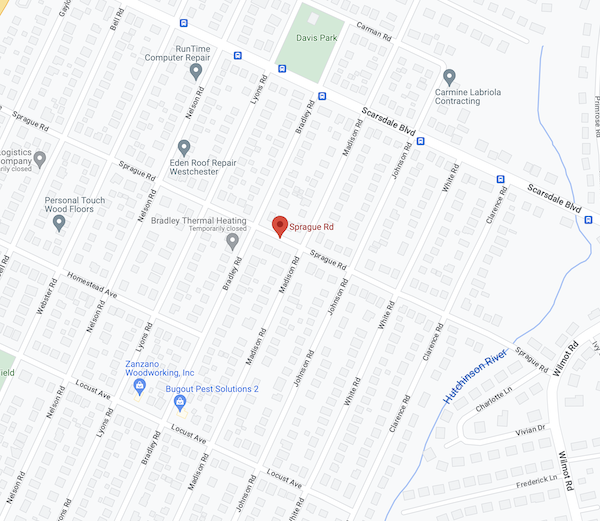 Stop signs on Boulevard and Locust have caused traffic to move to Sprague Road.
Stop signs on Boulevard and Locust have caused traffic to move to Sprague Road.
About the consultant’s proposals she said, “Placing a hazard in the intersection without a stop sign is expensive and there is nothing comparable anywhere. Will a bus be able to negotiate around this traffic island? What about kids standing out there waiting for the bus. It scares me. There is a telephone pole, a storm drain – you raise the risk that you’ll hit it. Why put a traffic circle on the top of a hill? It makes no sense. Chokers will cause accidents. We already have parked cars – and they are chokers and they get sideswiped. If we close the street, traffic will be diverted to Nelson which is already busy. I am against alternatives 2 and 3 – and we would like to see about stop signs. I would also like to see those solar panel speed signs. And I would like to see $500,000 used to repave Bell Road where you can’t ride a bike. Why can there be stop signs on Boulevard and Locust and not on Sprague?”
Cole responded, saying, “Even with the stop signs, Eastchester’s crash rates are much higher than Scarsdale’s. The more you put in, the more likely it is that people will ignore them and have an accident. The standards for stop signs are not met for Sprague Road.”
Linda Killian said, “I used to cross Sprague at Madison every day and I have almost been hit many times. Now I don’t go that way anymore. I would suggest you find solutions that work – like stop signs and enforcement. Find something that will work and keep people safe.”
Farley Baker said “I live at the corner of Johnson and Grand Boulevard. Now we have three sets of stop signs. They made a tremendous difference in slowing down traffic on Johnson. I can’t believe that there is no leeway in the criteria for stop signs. I don’t support the proposals.”
Ruth Berkowitz of 167 Madison Road said, “People speed like crazy on Madison Road and don’t expect the traffic. Why are we not speaking about the speed humps? That might make it more palatable.”
At one point, Mayor Justin Arest answered the residents by saying, “We are not forcing this on you for no reason. If you’re happy with the way things are we can leave it.”
And that’s what just might happen if the neighbors don’t come to some agreement about what they would like to be done. With stop signs off the list of options, and a limited appetite for chokers, half closures and traffic circles, they might just be left asking the police for better speed limit enforcement.
Westchester County Law Will Reduce the Use of Plastic Utensils
- Details
- Written by Joanne Wallenstein
- Hits: 1119
 In a significant step towards environmental sustainability, Westchester County is reminding residents and business owners of its "Upon Request" single-use foodware law, which will take effect on September 2. This legislation aims to reduce the consumption of single-use plastics by promoting a more mindful approach to their usage within food service establishments by limiting the use of single-use foodware products to only when specifically requested by the customer.
In a significant step towards environmental sustainability, Westchester County is reminding residents and business owners of its "Upon Request" single-use foodware law, which will take effect on September 2. This legislation aims to reduce the consumption of single-use plastics by promoting a more mindful approach to their usage within food service establishments by limiting the use of single-use foodware products to only when specifically requested by the customer.
Westchester County Executive George Latimer was joined by the Westchester County Legislators Vice-Chair Nancy Barr, Legislator Erika Pierce, DoH and DEF as they outline the key tenets of this new law. The Board of Legislators took up this effort and passed legislation spearheaded by Barr and Pierce and signed by Latimer. Latimer said: “Westchester County is once again taking steps to lessen the waste we put back into the waste stream. From large scale measures to simple changes in our daily behavior, every little bit counts toward our
goal of leaving a cleaner planet for future generations.”
The key tenets of the law include:
• Effective September 2, no food service establishment within Westchester County may provide single- use foodware or condiment packets to dine-in or take-away customers unless expressly requested. This pertains to items such as forks, knives, spoons, chopsticks, cup sleeves, beverage lids and condiment
packets.
• Upon customer request, single-use foodware items or condiment packets must be provided individually, rather than in packages containing multiple items. This initiative is aimed at curbing unnecessary plastic waste and promoting a more sustainable approach to dining.
• The law applies across various ordering methods, including in-person, online and through food delivery apps. Customers are encouraged to ask for single-use items only when needed, fostering responsible consumption.
• Single-use plastic beverage stirrers and "splash sticks" will no longer be permitted within food service establishments. Retail stores may still offer these items for sale to their customers.
• The legislation upholds existing protocols for utensil storage within food service establishments, maintaining standards of cleanliness and sanitation. Utensils available in self-service containers for consumers must be individually wrapped or placed face-down, with single-item dispensers recommended.
• All DoH requirements for health and safety remain in full effect, ensuring that the well-being of patrons is not compromised.
• DEF and DoH Inspectors will collaboratively work to ensure the proper implementation and adherence to the new regulations, promoting a seamless transition for both establishments and customers.
• Food service establishments are required to prominently display a clearly legible sign informing customers that plastic utensils, condiments, and straws are available only upon request. This sign, provided by the County, will serve to increase awareness and encourage responsible plastic use.
DoH Commissioner Dr. Sherlita Amler said: “The Westchester County Department of Health is proud to support this new law. Protecting the environment and reducing waste is the cornerstone of Environmental Health. We know that this is an important step in helping to maintain a healthy environment for our residents”DEF Deputy Commissioner Lou Vetrone said: “Billions of single-use plastic items end up in our waste stream every year. Due to the small size and narrow shape of these materials, they are not easily recyclable.
Fortunately, County Executive Latimer and the Board of Legislators have taken decisive action to significantly reduce the amount of single-use plastic items in our waste with the enactment of this legislation. The Department of Environmental Facilities looks forward to working with the Department of Health to educate residents and food service establishments on the new requirements and to ensure compliance.”
This change not only lessens the waste we all put into the waste stream, but also will provide significant cost savings to small business owners. Barr said: “This legislation is a win-win, as it will help protect our environment by decreasing items in the waste stream, while at the same time lowering costs for businesses, who will no longer provide items which go straight into the garbage. Equally important is the fact that consumers will get accustomed to making a conscious choice about what they actually need.
I hope Westchester residents and businesses will join with us to help spread the word, and that we will all do our part to comply to reduce waste.”
Commenting on the news, the Scarsdale Conservation Advisory Council said, "The CAC is happy to be part of and help this single-use plastic waste reduction effort. And residents can help too! When ordering or picking up food please only take plastic utensils if you need them – and check inside your bag before you leave to make sure nothing was put in there! If they were perhaps kindly remind the establishment of the new law. When ordering food online please opt out of receiving extra plasticware, and if there isn't an optout option on the ordering site, put it in the notes section. Together we can make this initiative a great success and Scarsdale can again be a model for the county-at-large of how we all can make small changes in our everyday lives to positively impact our environment."
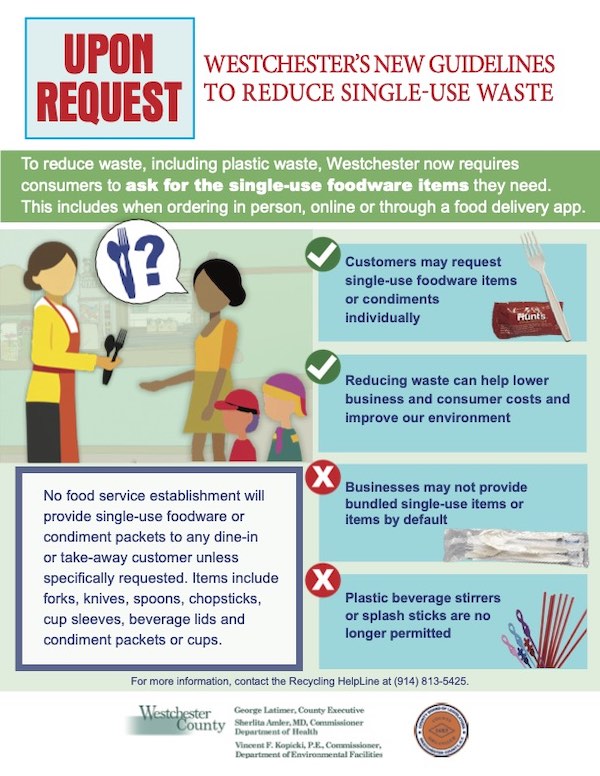
You're Invited to a Work Session on Traffic Calming Measures for Sprague Road
- Details
- Written by Joanne Wallenstein
- Hits: 708
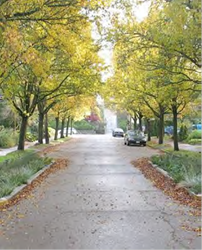 Join Village officials to discuss proposed traffic calming strategies for Sprague Road on August 01 at 5:30 PM in Rutherford Hall at Village Hall.
Join Village officials to discuss proposed traffic calming strategies for Sprague Road on August 01 at 5:30 PM in Rutherford Hall at Village Hall.
Because of an elevated instance of crashes in comparison with other Scarsdale residential streets of the same character, Sprague was the subject of a consultant study to develop innovative alternatives for enhancing safety and neighborhood quality of life. Their report was completed in October 2022 and the upcoming work session is a precursor to initiating engineering and construction for a preferred alternative.
The images shown here depict some of the infrastructure elements still under consideration. Village officials encourage residents along Sprague Road and the roads intersecting with it, as well as other Sprague Road users, to attend the August 01 work session either in person orby Zoom to help make the project a success.